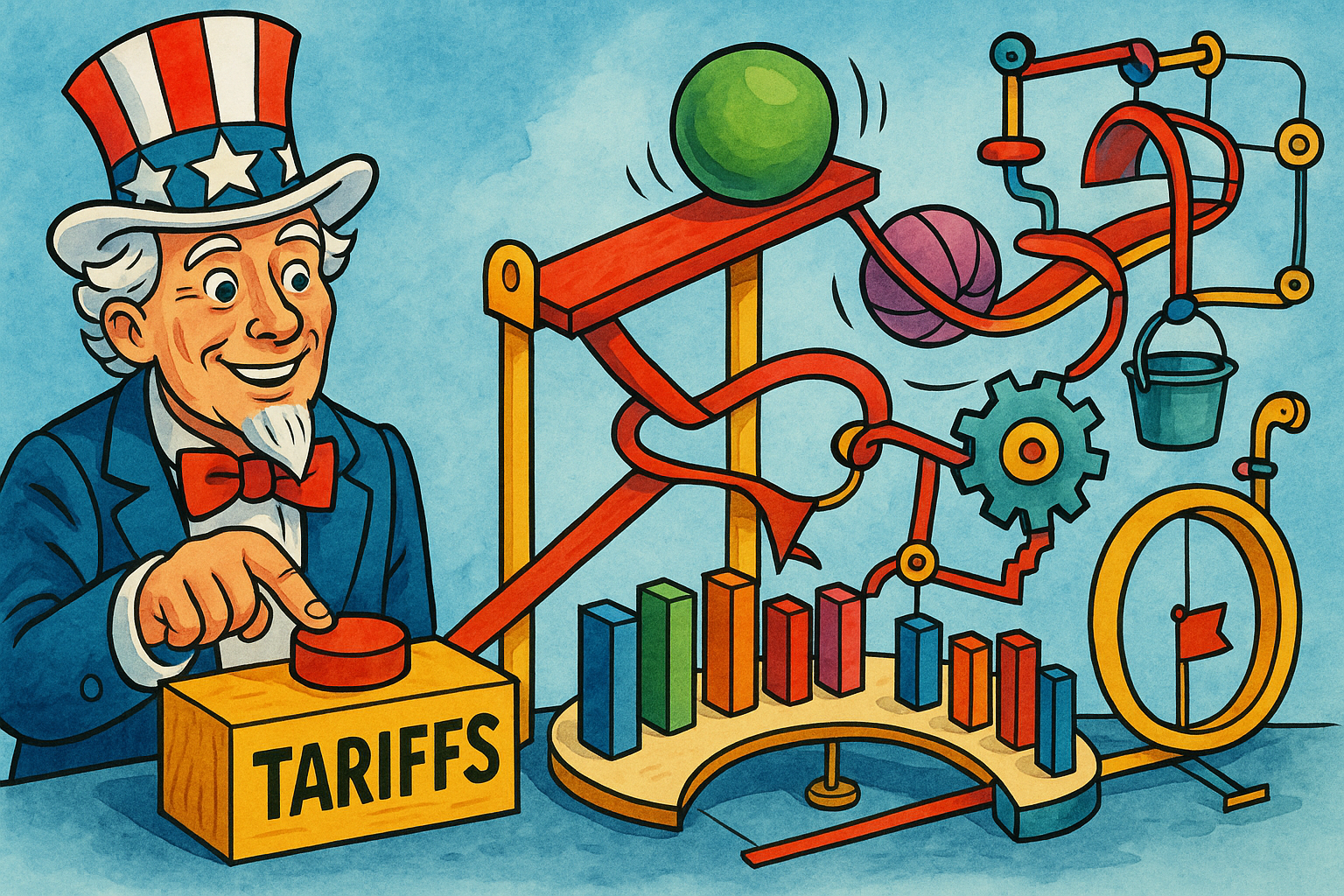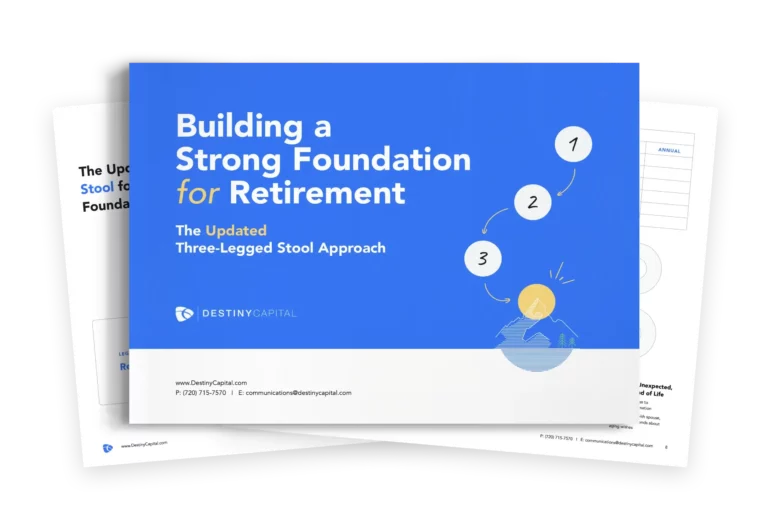A Note on Volatility
by Tim Doyle, CFP®, MBA
Over the course of my career, I’ve visited the offices and headquarters of many wealth management and financial planning firms across many states. In the waiting room of most of these firms, I’d often find several televisions mounted on the walls with one tuned to Fox Business, another to CNBC, and another to Bloomberg TV. Stock tickers and red & green numbers would rapidly scroll across each screen as panels of pundits would vociferously argue about an imminent collapse of a commodity, currency, company or sector. Each time I’d sit in these waiting rooms, I’d feel my blood pressure rapidly rise from about 120/80 to 160/90 over the course of just a few minutes.
Conversely, I vividly recall the first time I walked into the Destiny Capital offices for an initial job interview many, many years ago. To my surprise, in the waiting area, I wasn’t met with Jim Cramer shouting at me to sell Apple stock, but I sat across from a single flat screen television that scrolled through calm blue ocean scenes from beautiful locations across the globe. “These guys get it”, I remembered thinking at the time, and I became a part of the Destiny team a few weeks later.
You see, investing isn’t about timing the markets or the talent of an analyst – it’s largely about temperament. An investor who I’ve always admired throughout my career is the late, great Peter Lynch who managed the venerable Magellan Fund at Fidelity. One of my favorite quotes of Lynch is from his book One Up on Wall Street where he writes, “The trick (to investing) is not to learn to trust your gut feelings, but rather to discipline yourself to ignore them.” I couldn’t agree more with this statement. This is why we’ve adopted words like ‘Discipline’ and ‘Data Driven’ as core principles of investing here at Destiny Capital.
I’d imagine that many of you may be alarmed by what you are seeing, hearing, and reading about as it relates to the stock market and the economy. Your gut may be nudging you to take some kind of action. After two years of strong returns, the S&P 500 has experienced a sudden correction. To steal another Peter Lynch line, “a correction is just a euphemism for losing a lot of money rapidly.”
Experiencing a market correction can be quite stressful, but it’s important to remember that the volatility we have seen in the stock market in recent days and weeks is completely normal. I hesitate to say things like this, but volatility is typically a sign of a healthy market. I know, I know. That’s a lot like somebody telling you it’s healthy to stub your toe on the way to the bathroom in the middle of the night. Hearing “it’s healthy” sure doesn’t make it feel any better. However, sometimes certain asset prices can get a little bloated, and it’s healthy to shed some of that bloat before it becomes a bubble.
In fact, the absence of volatility over the past two years has been abnormal, and this is something we’ve communicated in past investor letters and webinars. To give you a historical perspective on this, over the past 45 years, the S&P 500 has averaged a -14.1% intra-year decline. Yet, despite those steep drawdowns, calendar year returns ended up positive in 34 of the past 45 years. You can see this dynamic in the chart below with the red dots representing the intra-year decline each year while the grey bars represent the calendar year returns for the S&P 500.
Source: JP Morgan Asset Management – Guide to the Markets
It is also impossible to time the market. Emotionally, it might feel easy to sell during times like these when there’s so much uncertainty and volatility. However, this then begs the question “if you sell to cash, when do you buy back in?” After all, this recent bout of inflation has shown us how quickly the purchasing power of cash can erode, so it’s imperative to invest in order for an investor to achieve their financial goals and maintain or improve their desired lifestyle.
As the past few weeks have shown us, markets also tend to move quickly, and the S&P 500 can ascend just as quickly as it descends. Rebounds can happen suddenly, and are often spurred by something unexpected. In fact, the best days in the stock market tend to occur within two weeks of the worst days.
Missing even a portion of a market recovery can be catastrophic for long-term investor returns. The chart below helps to illustrate this point by showing S&P 500 returns over the past 20 years. The chart compares market returns and the growth of $10,000 as-if an investor remained fully invested (and experienced all the ups and downs) versus if they periodically sold to cash and missed 10, 20, or more of the market’s best days during that time. Missing days when the stock market moves higher can prove costly in the long run.
JP Morgan Asset Management – Guide to Retirement
As I’ve written many times, investors loathe uncertainty. Uncertainty breeds fear, and fear leads to volatility and panic selling. There is a tremendous amount of uncertainty around the trade policies of the Trump administration, and the specter of a global trade war weighs heavily on the minds of business owners, employees, investors and citizens worldwide. This is ultimately the cause of the volatility markets are experiencing today.
This level of uncertainty helps to stress why diversification can be so important for many investors who are hoping to experience a smoother ride over time. As portfolio managers, we focus quite a bit on how certain asset classes move in relation to one another. We refer to this as ‘correlation’. Ultimately, when constructing client portfolios, we want a portion of a portfolio that zigs while another portion zags.
As a very basic example of this dynamic, we look at the performance of stocks and bonds since the start of 2025. As you can see in the chart below, bonds are actually up +2% this year while the S&P 500 has fallen -4.6% since January 1st. So, in a diversified portfolio that includes fixed income, an investor should not be experiencing the full brunt of the daily volatility markets have experienced over the past few weeks. This can help investors navigate short term periods where stocks decline sharply and panic selling ensues.
To close, I want to point out that there simply isn’t enough actionable data to warrant meaningful portfolio changes when so much uncertainty exists. For many clients who have worked with us over the years, this isn’t our first rodeo. As investors, we’ve been through quite a lot together even in just the last three-to-five years whether it be a global pandemic, war between Russia and Ukraine, bank failures, soaring inflation, sky-high interest rates, and more.
Throughout every single one of these events, I’ve heard many pundits and ‘experts’ claim, “Yeah, but this time it’s different.” Yet, look at the chart below and see how high markets have ascended through seemingly insurmountable obstacles at times.
Source: JP Morgan Asset Management – Guide to the Markets
This chart also demonstrates that the path of an investor is far from linear, and it certainly isn’t for the faint of heart at times. Therefore, please rest assured that we are here and are monitoring all emerging developments by the minute on your behalf. As always, we will keep you updated as circumstances evolve and as conditions change. Ultimately, our goal is to have you turn off all of the business & finance news networks so you can focus on your calm blue ocean. Outsource that stress to us. It is why we are here. Still, if you are losing sleep at night or if you simply have questions about your portfolio, I would encourage you to reach out to your Client Wealth Strategists for a conversation.
Important note and disclosure: This article is intended to be informational in nature; it should not be used as the basis for investment decisions. You should seek the advice of an investment professional who understands your particular situation before making any decisions. Investments are subject to risks, including loss of principal. Past returns are not indicative of future results. Advisory services offered through Destiny Capital Corporation, an Investment Adviser registered with the U.S. Securities & Exchange Commission.
2024 YCharts, Inc. All Rights Reserved. YCharts, Inc. (“YCharts’) is not registered with the U.S. Securities and Exchange Commission (or with the securities regulatory authority or body of any state or any other jurisdiction) as an investment adviser, broker-dealer or in any other capacity, and does not purport to provide investment advice or make investment recommendations. This report has been generated using data manually input by the creator of this report combined with data and calculations from YCharts.com and is intended solely to assist you or your investment or other adviser(s) in conducting investment research. You should not construe this report as an offer to buy or sell, as a solicitation of an offer to buy or see, or as a recommendation to buy, sell, hold or trade, any security or other financial instrument. THE IMPORTANT DISCLOSURES FOUND AT THE END OF THIS REPORT (WHICH INCLUDE DEFINITIONS OF CERTAIN TERMS USED IN THIS REPORT) ARE AN INTEGRAL PART OF THIS REPORT AND MUST BE READ IN CONJUNCTION WITH YOUR REVIEW OF THIS REPORT. Disclosure – YCharts
Share this
Stay Ahead with Smart Investments
Learn how to invest wisely and minimize risks to protect your retirement savings.
Achieve Your Retirement Goals
Get personalized advice to meet your retirement goals. Book your call with Destiny Capital now.




